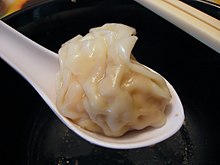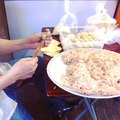Wonton
Wan Tan , also Wantan or Huntun ( Chinese 餛飩 / 馄饨 , Pinyin húntun , Jyutping wan 4 tan 1 , Cantonese wɐn4tɐn1 , English Wonton, Wunton ) are dumplings from Chinese cuisine . The generally popular spelling “Wan Tan” has its origins in Cantonese and reflects the use of English writing conventions , while the term “Huntun”, on the other hand, is derived from standard Chinese derives.
Designations
The term Chausou ( 抄手 , chāoshǒu "to clasp hands", "to put hands in the sleeves" ), a term for wonton or huntun that is rarely found in the West , comes from the Sichuan dialect . A well-known dish of the Sichuan cuisine is z. B. Chausou in chili oil according to Sichuan style ( 紅油 抄手 / 红油 抄手 , hóngyóu chāoshǒu - "Chaosou, thus Huntun according to Sichuan style, in red oil"). In the local language area of the Peking dialect in northern China and the Min Nan in southeast China or Taiwan , the term Bianshi ( 扁食 , biǎnshí , Pe̍h-ōe-jī pián-sit ) can be found for Wan Tan, but in standard Chinese it also means " Pastry similar to dumplings ”as Jiaozi says. The common term pangsit for wonton in certain Southeast Asian countries, such as Indonesia , was probably coined or made famous by local Chinese people who speak Chinese abroad .
The alternative case as a character for wontons " 雲吞 / 云吞 " (Pinyin yúntūn , Jyutping wan4tan1 ) is an unofficial homophonic writing in Cantonese for the correct spelling " 餛飩 / 馄饨 (Pinyin" Huntun , Jyutping wan4tan1 ) in China . It is mostly only used in the Cantonese-speaking area , Hong Kong and Macau . This spelling found its way into the Japanese language through Cantonese overseas Chinese ( Japanese ワ ン タ ン / 雲 呑 ).
Ingredients and preparation
Wontons are bags Weizennudelteig that a filling of meat (usually pork , sometimes poultry , rare beef ), seafood (mostly fish, shrimp , rare abalone ) and other ingredients, such as vegetables (eg. As Chinese cabbage , garlic chives , shepherd's purse ), Mushrooms (e.g. shiitake mushroom ) and other minced meat.
To make the wontons, the ingredients for the filling are chopped up, mixed together, seasoned and pre-cooked. Then the filling is wrapped in pastry sheets. The wonton dough sheets made from wheat noodle dough are either industrially prefabricated or made by hand from self-kneaded dough. Dough sheets for wonton are relatively thin compared to Jiaozi dough sheets. They are usually square and have a side length of about six centimeters. As a regional specialty, wontons in China not only have different names. They can have different shapes depending on the region. Depending on the technique, round, semicircular, triangular or boat-like wontons can be formed.
During preparation, the wontons are cooked either in a steam bath in baskets or in a hot broth or hot water bath, then served in a basket or added to a soup, the wonton soup.
On European menus they occasionally appear fried in the variant as "(baked) wonton " and are usually served with sweet and sour sauce, which in Indonesian cuisine is called pangsit goreng . The alternative way to prepare wontons with noodles is also popular. As a pasta dish, it can be differentiated as noodle soup or noodles with sauce. The wonton noodle soup, which is regionally known in Taiwan as Biansi noodle soup, is popular.
See also: Dim Sum
preparation
Web links
Individual evidence
- ↑ a b Term "Huntun (馄饨 / 餛飩)", Chinese: [1] on zdic.net, accessed on February 1, 2016 - online
- ↑ term "Chausou (抄手)", Chinese: [2] on zdic.net, accessed on February 1, 2016 - Online
- ↑ term "Bianshi (扁食)", Chinese: [3] on zdic.net, accessed June 17, 2017 - Online
- ^ Term "Pián-sit (扁食)", Minnan: [4] on twblg.dict.edu.tw, accessed on June 17, 2017 - online
- ↑ Article “Pangsit Goreng”, English: [5] on yelp.com, accessed on October 30, 2017 - online
- ↑ Cooking recipe “Pangsit Goreng”, English: [6] on feralkitchen.com, accessed on October 30, 2017 - online
- ↑ Cooking recipe "Kochwiki recipe Pangsit Goreng", English: [7] on kochwiki.org, accessed on October 30, 2017 - online
- ↑ Term "Wantan (ワ ン タ ン)", Japanese: [8] on tangorin.com, accessed on February 1, 2016 - online
- ↑ term "Wantan (雲吞)", Japanese: [9] on wadoku.de, accessed on February 1, 2016 - Online
- ↑ Recipe “Baked Wontons with Mushroom Filling”, [10] on ndr.de, Cooking Advice , accessed on February 1, 2016 - Online












